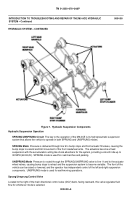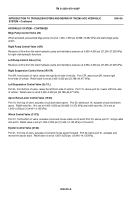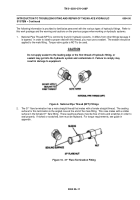TM-5-2350-378-24-P - Page 41 of 790
TM 5--2350--378--24&P
0004 00--16
INTRODUCTION TO TROUBLESHOOTING AND REPAIR OF THE M9 ACE HYDRAULIC
SYSTEM -- Continued
0004 00
GENERAL
The causes of many hydraulic system malfunctions cannot be isolated by visual inspection and require special
procedures to locate. When a thorough visual inspection does not indicate the cause of a hydraulic malfunction,
troubleshoot the hydraulic system to locate the faulty component. The troubleshooting procedures in this work
package and in individual troubleshooting work packages (WP 0005 00 through WP 0022 00) cannot cover all the
possible malfunctions and deficiencies that may occur on the M9. Carefully listen and observe all hydraulic
actions to assist in the location of troubles. The more symptoms that can be evaluated, the easier it will be to
isolate the defect.
Refer to the information in this work package for preliminary troubleshooting procedures and connections of test
equipment and adapters necessary for fault isolation. While troubleshooting the hydraulic system, refer to the
vehicle hydraulic schematic diagram to determine flow paths, pressures, routing of lines, and position of control
valves.
GENERAL NOTES
WARNING
S
High pressure is present in the M9 hydraulic system. Do not disconnect any hy-
draulic system component unless hydraulic pressure has been relieved. Ensure
each hydraulic control lever is moved several times through all positions and hy-
draulic tank dipstick is slowly loosened to relieve pressure. Failure to comply may
result in severe injury or death to personnel.
S
Before performing any hydraulic troubleshooting in the bowl, move the ejector for-
ward and disable it by disconnecting the ejector cylinder or by engaging the ejector
lock. Failure to comply may result in severe injury or death to personnel.
Hydraulic troubleshooting can often be reduced by taking the following steps:
S
Before removing the hull access plates from the bottom of the hull, thoroughly and carefully inspect all
readily and easily accessible hydraulic lines and components for leaks or damage.
S
If hull access plates must be removed from the bottom of the hull, remove the front access plates first.
More suspension malfunctions occur in the front of the vehicle than at the rear.
S
Always observe the general hydraulic system repair methods described in this work package.
S
Instead of replacing a relief valve for troubleshooting purposes, temporarily switch it with another relief
valve on the directional control valve bank.
S
Instead of replacing an HDC System solenoid valve or pressure transducer, temporary switch it with a
spare item, or with another identical solenoid valve or pressure transducer.
S
When proceeding from one troubleshooting task to another, read the next task to determine what test
equipment or configuration is required. Time can be saved by not repeating gauge, fitting, and hose
connections, where applicable.
When troubleshooting is complete, make sure all test equipment and test fittings are removed, and all hydraulic
components are returned to the original configuration, before operating the vehicle.
Back to Top




















